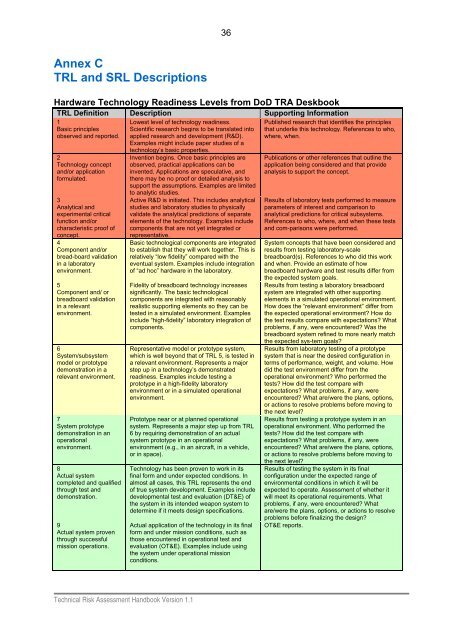Technical Risk Assessment Handbook - Defence Science and ...
Technical Risk Assessment Handbook - Defence Science and ...
Technical Risk Assessment Handbook - Defence Science and ...
Create successful ePaper yourself
Turn your PDF publications into a flip-book with our unique Google optimized e-Paper software.
36<br />
Annex C<br />
TRL <strong>and</strong> SRL Descriptions<br />
Hardware Technology Readiness Levels from DoD TRA Deskbook<br />
TRL Definition Description Supporting Information<br />
1<br />
Basic principles<br />
observed <strong>and</strong> reported.<br />
2<br />
Technology concept<br />
<strong>and</strong>/or application<br />
formulated.<br />
3<br />
Analytical <strong>and</strong><br />
experimental critical<br />
function <strong>and</strong>/or<br />
characteristic proof of<br />
concept.<br />
4<br />
Component <strong>and</strong>/or<br />
bread-board validation<br />
in a laboratory<br />
environment.<br />
5<br />
Component <strong>and</strong>/ or<br />
breadboard validation<br />
in a relevant<br />
environment.<br />
6<br />
System/subsystem<br />
model or prototype<br />
demonstration in a<br />
relevant environment.<br />
7<br />
System prototype<br />
demonstration in an<br />
operational<br />
environment.<br />
8<br />
Actual system<br />
completed <strong>and</strong> qualified<br />
through test <strong>and</strong><br />
demonstration.<br />
9<br />
Actual system proven<br />
through successful<br />
mission operations.<br />
Lowest level of technology readiness.<br />
Scientific research begins to be translated into<br />
applied research <strong>and</strong> development (R&D).<br />
Examples might include paper studies of a<br />
technology’s basic properties.<br />
Invention begins. Once basic principles are<br />
observed, practical applications can be<br />
invented. Applications are speculative, <strong>and</strong><br />
there may be no proof or detailed analysis to<br />
support the assumptions. Examples are limited<br />
to analytic studies.<br />
Active R&D is initiated. This includes analytical<br />
studies <strong>and</strong> laboratory studies to physically<br />
validate the analytical predictions of separate<br />
elements of the technology. Examples include<br />
components that are not yet integrated or<br />
representative.<br />
Basic technological components are integrated<br />
to establish that they will work together. This is<br />
relatively “low fidelity” compared with the<br />
eventual system. Examples include integration<br />
of “ad hoc” hardware in the laboratory.<br />
Fidelity of breadboard technology increases<br />
significantly. The basic technological<br />
components are integrated with reasonably<br />
realistic supporting elements so they can be<br />
tested in a simulated environment. Examples<br />
include “high-fidelity” laboratory integration of<br />
components.<br />
Representative model or prototype system,<br />
which is well beyond that of TRL 5, is tested in<br />
a relevant environment. Represents a major<br />
step up in a technology’s demonstrated<br />
readiness. Examples include testing a<br />
prototype in a high-fidelity laboratory<br />
environment or in a simulated operational<br />
environment.<br />
Prototype near or at planned operational<br />
system. Represents a major step up from TRL<br />
6 by requiring demonstration of an actual<br />
system prototype in an operational<br />
environment (e.g., in an aircraft, in a vehicle,<br />
or in space).<br />
Technology has been proven to work in its<br />
final form <strong>and</strong> under expected conditions. In<br />
almost all cases, this TRL represents the end<br />
of true system development. Examples include<br />
developmental test <strong>and</strong> evaluation (DT&E) of<br />
the system in its intended weapon system to<br />
determine if it meets design specifications.<br />
Actual application of the technology in its final<br />
form <strong>and</strong> under mission conditions, such as<br />
those encountered in operational test <strong>and</strong><br />
evaluation (OT&E). Examples include using<br />
the system under operational mission<br />
conditions.<br />
Published research that identifies the principles<br />
that underlie this technology. References to who,<br />
where, when.<br />
Publications or other references that outline the<br />
application being considered <strong>and</strong> that provide<br />
analysis to support the concept.<br />
Results of laboratory tests performed to measure<br />
parameters of interest <strong>and</strong> comparison to<br />
analytical predictions for critical subsystems.<br />
References to who, where, <strong>and</strong> when these tests<br />
<strong>and</strong> com-parisons were performed.<br />
System concepts that have been considered <strong>and</strong><br />
results from testing laboratory-scale<br />
breadboard(s). References to who did this work<br />
<strong>and</strong> when. Provide an estimate of how<br />
breadboard hardware <strong>and</strong> test results differ from<br />
the expected system goals.<br />
Results from testing a laboratory breadboard<br />
system are integrated with other supporting<br />
elements in a simulated operational environment.<br />
How does the “relevant environment” differ from<br />
the expected operational environment How do<br />
the test results compare with expectations What<br />
problems, if any, were encountered Was the<br />
breadboard system refined to more nearly match<br />
the expected sys-tem goals<br />
Results from laboratory testing of a prototype<br />
system that is near the desired configuration in<br />
terms of performance, weight, <strong>and</strong> volume. How<br />
did the test environment differ from the<br />
operational environment Who performed the<br />
tests How did the test compare with<br />
expectations What problems, if any, were<br />
encountered What are/were the plans, options,<br />
or actions to resolve problems before moving to<br />
the next level<br />
Results from testing a prototype system in an<br />
operational environment. Who performed the<br />
tests How did the test compare with<br />
expectations What problems, if any, were<br />
encountered What are/were the plans, options,<br />
or actions to resolve problems before moving to<br />
the next level<br />
Results of testing the system in its final<br />
configuration under the expected range of<br />
environmental conditions in which it will be<br />
expected to operate. <strong>Assessment</strong> of whether it<br />
will meet its operational requirements. What<br />
problems, if any, were encountered What<br />
are/were the plans, options, or actions to resolve<br />
problems before finalizing the design<br />
OT&E reports.<br />
<strong>Technical</strong> <strong>Risk</strong> <strong>Assessment</strong> <strong>H<strong>and</strong>book</strong> Version 1.1

















